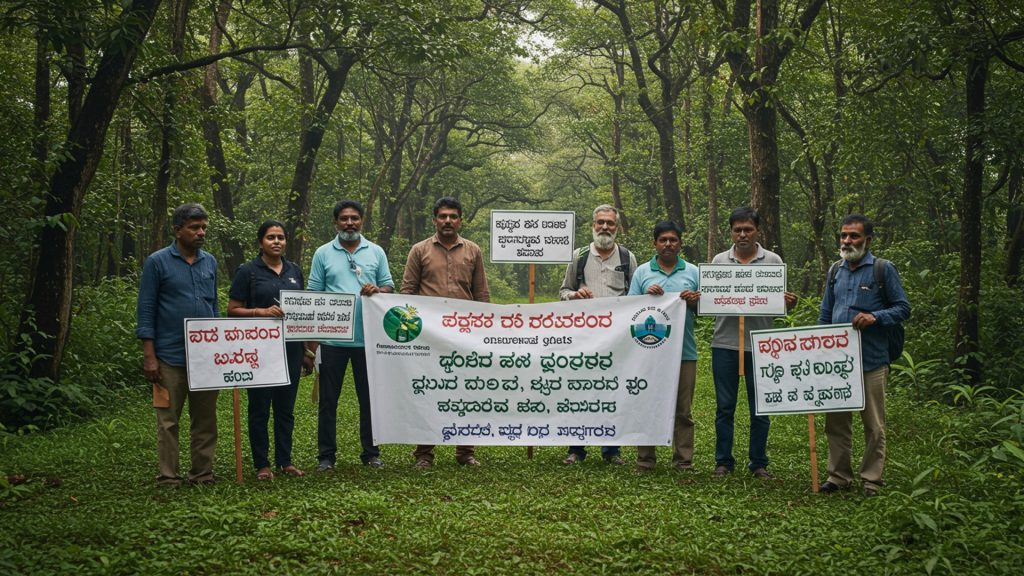Environmental groups are now fighting hard against the Sharavathi Power Project, a big plan that wants to build a new power plant in the rich forests of the Western Ghats. This project, pushed by government power companies, threatens to drown many acres of old forest and move thousands of people from their homes. Today, activists are holding protests and meeting with leaders, saying the project will harm nature and local ways of life forever. They call for the plan to stop right now, as the fight to save this special natural area gets more urgent.
The Project at the Heart of the Debate
The Sharavathi Pumped Storage Hydroelectric Project is a large plan put forward by the Karnataka Power Corporation Limited (KPCL). This project aims to make and store 2,000 megawatts of electricity, making it the biggest pumped storage power unit in the country if built. The main idea behind this project is to act like a giant battery for electricity. Water will be pumped up to an upper reservoir, the Talakalale dam, during times when there is less demand for power. Then, when more electricity is needed, this water will be let down through turbines to a lower reservoir, the Gerusoppa dam, to make power.
The total cost of this project is estimated to be around 8,000 crore rupees to over 10,240 crore rupees. KPCL says the project will help meet the growing need for electricity in Karnataka and make the power grid stronger. The company that has been given the contract to build this project is Megha Engineering & Infrastructures Limited (MEIL). The project was first approved by the KPCL board in 2016. then by the state government in 2017. The Central Electricity Authority also gave its approval in August 2024. Besides making electricity, the project also has a goal to supply drinking water to Bengaluru.
Protecting the Natural World
The Sharavathi Pumped Storage Project has caused a lot of worry among people who care about nature and local communities. The project is planned for the Sharavathi Valley, which is part of the Western Ghats. This area is very crucial for its rich variety of plants and animals. A major concern is that the project needs to use land that is inside the Sharavathi Valley Lion-tailed Macaque Sanctuary.
This sanctuary is home to many rare animals, including the endangered Lion-tailed Macaque and the vulnerable Great Indian Hornbill. Environmental groups say that building this project would mean cutting down more than 15,000 trees and taking over 54. 155 hectares (about 133. 8 acres) of forest land. A part of this land, about 14. 582 hectares, is directly inside the sanctuary. This is a big problem because Karnataka’s forest cover is already low, around 20%, which is less than the national goal of 33%.
People who oppose the project argue that it goes against a very essential law, the Wildlife Protection Act of 1972. They say that this law stops any harm to wildlife or their homes inside a sanctuary unless it is clearly for the good of the animals, which they believe this project is not. There are also worries about the safety of the land itself. Reports show that cutting steep slopes and blasting rocks for tunnels could lead to more landslides, especially in an area like Shivamogga, which already faces risks from landslides and floods.
“Section 29 of the Wildlife Protection Act clearly prohibits any kind of destruction of wildlife including its habitat inside a wildlife sanctuary unless the destruction is unambiguously for the betterment of wildlife and its habitat. The proposed power plant would certainly not benefit wildlife or its habitat. will only destroy a considerable portion of that habitat. This project will, hence, be a clear violation of the Wildlife Protection Act, 1972,” Shankar Sharma, power policy analyst told The Wire.
Some experts have also questioned how well the project will work, saying it might use more electricity to pump water than it actually makes, which could make it not worth the money.
Concerns of Local People
The project also brings serious concerns for the people living in the Sharavathi Valley. Residents in villages like Henni, Marathi camp, Gundibylu. Jadagallu are worried about being moved from their homes for a second time. Many of these families were already moved about 50 years ago because of the first Sharavathi hydroelectric project.
Local authorities have sent notices about taking over around twelve houses and their land. Villagers have said that the forest department has allowed trees to be marked near their homes even though the project does not have full official approval. There are complaints about not getting enough money for their property and a lack of clear data about land rights. Some residents have spoken about sleepless nights and feeling like leaving their village would be like suicide.
“Santosh, 45, criticised the arbitrary compensation of Rs 10 lakh offered without proper property assessment. His son Shivanand, who discontinued education after class 10 due to financial constraints, described their sleepless nights and likened leaving their village to suicide.”
Official Decisions and Court Cases
The Karnataka Power Corporation Limited (KPCL) defends the project by saying it has received some approvals. The state wildlife board gave its approval in January 2025. it added conditions, asking for very little tree cutting and for much of the building work to be done underground. But, some people believe this approval was given under pressure.
More crucial approvals from the central government, like those from the Ministry of Environment, Forests and Climate Change (MoEFCC) and the National Board for Wildlife (NBWL), have been difficult to get. The MoEFCC actually turned down the request for forest clearance in May 2025. It pointed to the high risk of landslides and the damage the project would cause to the Western Ghats. The Forest Advisory Committee also put off making a decision on the project in August 2025, asking for more clear details about tree cutting. While the NBWL gave “in-principle” approval in July 2025, environmental groups still have strong worries about its effect on the sanctuary.
The project has also faced problems in court. The Karnataka High Court got involved in the process of choosing a company to build the project. In March 2024, the court put a stop to all work related to the project’s short-term contract because of claims that the process was not fair and had problems. Another company, Larsen & Toubro (L&T), had challenged the way the contract was given out, saying it was done too quickly. Even though a stay order was issued, KPCL had already given the contract to Megha Engineering and Infrastructures Ltd before the court’s decision was made public.
Calling for Change
Environmental groups and local people are actively speaking out against the Sharavathi project. They have formed groups like the “Sharavathi Nadi Kanive Ulisi Horata Okkoota” (Save Sharavathi River Valley Movement), Paryavaran Trust. Rashtriya Swabhiman Andolana. These groups have held public meetings, protest marches. submitted formal requests to government offices in Shivamogga and other areas. They are working to make more people aware of the potential harm the project could cause.
The people protesting are asking the state government to stop the project completely. They suggest that instead of building this large dam, the government should look at newer ways to store energy, such as battery power storage systems and smart grids. They believe these methods would meet the need for electricity without harming the delicate forest areas of the Western Ghats. They also argue that the idea of diverting water that flows to the sea is wrong, stating that this water is crucial for the climate and local wildlife.
Opposition parties have also criticised the state government, claiming that the contract was rushed to benefit certain interests. As the protests grow and more legal challenges come up, the future of the Western Ghats and its endangered animals is unclear.

